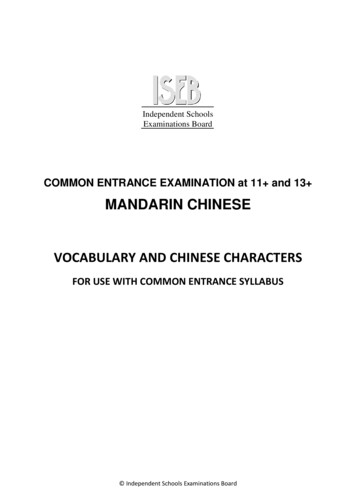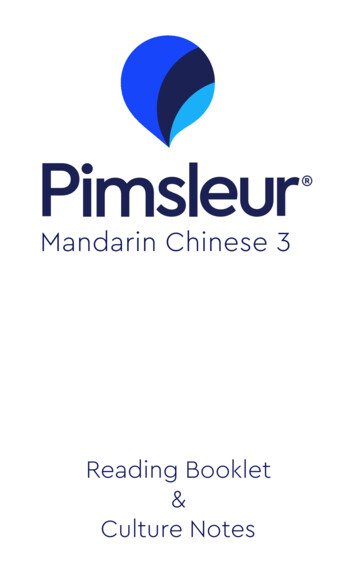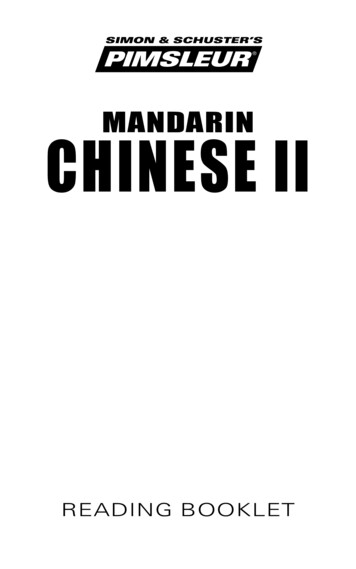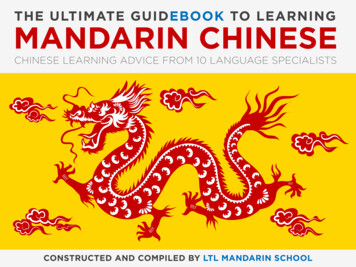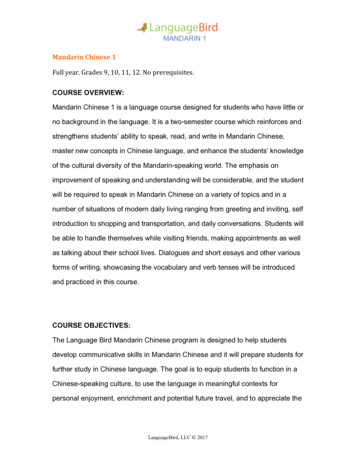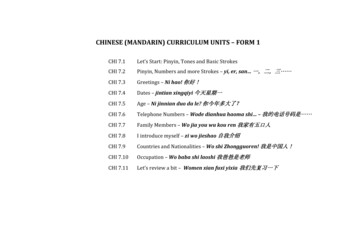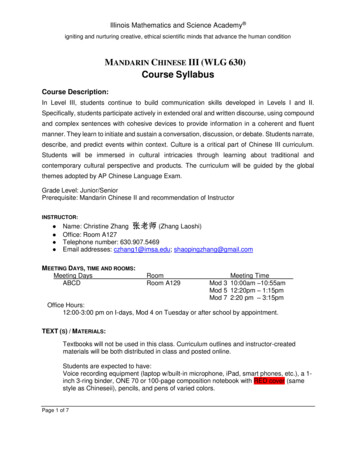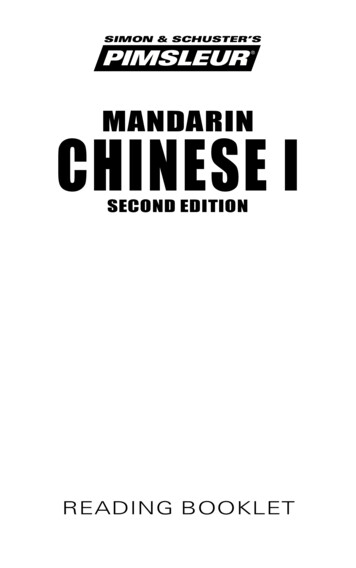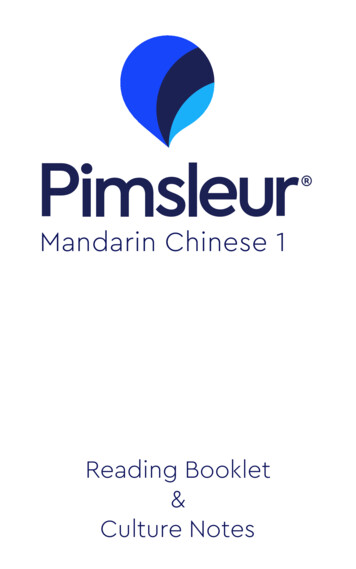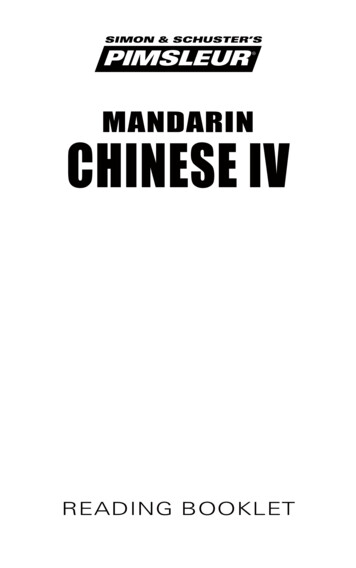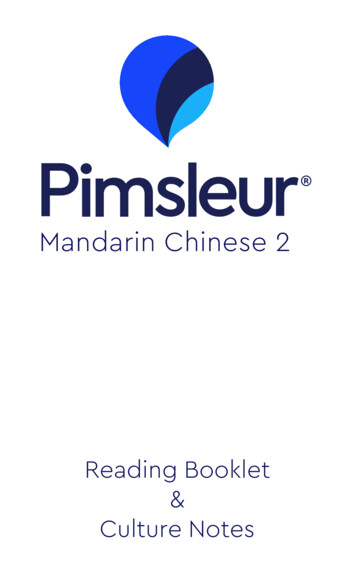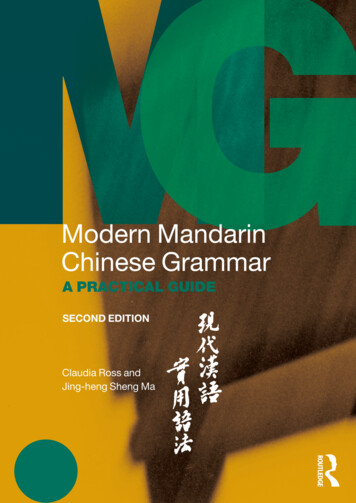
Transcription
ModernMandarin ChineseGrammarhttps://vk.com/readinglectureModern Mandarin Chinese Grammar provides an innovative reference guide to Mandarin Chinese,combining traditional and function-based grammar in a single volume.The Grammar is divided into two parts. Part A covers traditional grammatical categories suchas phrase order, nouns, verbs, and specifiers. Part B is carefully organized around languagefunctions and notions such as: Communication strategiesMaking comparisonsGiving and seeking informationExpressing apologies, regrets, and sympathiesThe two parts of the Grammar are closely linked by extensive cross-references, providing agrammatical and functional perspective on many patterns. All grammar points and functionsare richly illustrated with examples, with a strong focus on contemporary usage.Main features of the Grammar include: Examples given in simplified characters, traditional characters and romanization (pinyin)Clear explanations and accessible descriptionsParticular attention to areas of particular difficulty for learners of Mandarin ChineseImplementing feedback from users of the first edition of the Grammar, this second edition hasbeen revised throughout to offer expanded explanations, examples, cross-referencing, and indexing and brand new chapters on aspect, resultative verbs, directional verbs, and “ba” sentences.This is the ideal reference grammar for learners of Mandarin Chinese at all levels, from elementaryto advanced. No prior knowledge of grammatical terminology is assumed and a glossary ofgrammatical terms is provided. This Grammar is accompanied by the Modern Mandarin ChineseGrammar Workbook (978-0-415-83488-9) which features related exercises and activities.Claudia Ross is Professor of Chinese Language and Linguistics in the Department of ModernLanguages at the College of the Holy Cross in Worcester, Massachusetts, USA.Jing-heng Sheng Ma is Emeritus Professor of Chinese Studies at Wellesley College,Massachusetts, USA.
Routledge Modern GrammarsSeries concept and development – Sarah ButlerOther books in the seriesModern French Grammar, Second EditionModern French Grammar Workbook, Second EditionModern German Grammar, Second EditionModern German Grammar Workbook, Second EditionModern Italian Grammar, Third EditionModern Italian Grammar Workbook, Second EditionModern Brazilian Portuguese GrammarModern Brazilian Portuguese Grammar WorkbookModern Russian GrammarModern Russian Grammar WorkbookModern Spanish Grammar, Third EditionModern Spanish Grammar Workbook, Third EditionModern Japanese GrammarModern Japanese Grammar Workbook
lectureA Practical GuideSecond EditionClaudia RossJing-heng Sheng Ma
First published 2006 by RoutledgeThis second edition published 2014by Routledge2 Park Square, Milton Park, Abingdon, Oxon OX14 4RNand by Routledge711 Third Avenue, New York, NY 10017Routledge is an imprint of the Taylor & Francis Group, an informa business 2006, 2014 Claudia Ross and Jing-heng Sheng MaThe right of Claudia Ross and Jing-heng Sheng Ma to be identified as the authors of this work has beenasserted by them in accordance with sections 77 and 78 of the Copyright, Designs and Patents Act 1988.All rights reserved. No part of this book may be reprinted or reproduced or utilised in any form or by anyelectronic, mechanical, or other means, now known or hereafter invented, including photocopying andrecording, or in any information storage or retrieval system, without permission in writing from thepublishers.Trademark notice: Product or corporate names may be trademarks or registered trademarks,and are used only for identification and explanation without intent to infringe.British Library Cataloguing in Publication DataA catalogue record for this book is available from the British LibraryLibrary of Congress Cataloging in Publication DataRoss, Claudia.Modern Mandarin Chinese grammar : a practical guide / Claudia Ross, Jing-heng Sheng Ma. –Second Edition.pages cm. – (Routledge Modern grammars)Includes bibliographical references and index.1. Chinese language–Grammar. 2. Mandarin dialects–Grammar. 3. Mandarin dialects–Self-instruction. 4. Chinese language–Textbooks for foreign speakers–English. I. Ma, Jing-hengSheng. II. Title.PL1107.R65 2014495.1′82421–dc232013034333ISBN: 978-0-415-82715-7 (hbk)ISBN: 978-0-415-82714-0 (pbk)ISBN: 978-1-315-81475-9 (ebk)Typeset in Times New Romanby Graphicraft Limited, Hong Kong
tsIntroductionHow to use this bookGlossary of grammatical termsA note on Chinese charactersxvxvixviixviiixxviPart A Structures113Overview of pronunciation and Pinyin romanization1.1The Mandarin syllable 31.2Pinyin romanization 42 Syllable, meaning, and word2.1The special status of the Mandarin syllable 62.2Multi-syllable tendency in Mandarin words 72.3Word-specific tone changes 82.4Change to neutral tone 92.5Incorporating foreign words and naming foreign objects103The Chinese writing system: an overview3.1Traditional and simplified characters 123.2The structure of Chinese characters: the radical and the phonetic 123.3The traditional classification of characters 143.4Character stroke order: 笔顺/筆順 bǐshùn 12v6order in the Mandarin sentenceBasic phrase order 17The position of direct and indirect objects 17The position of prepositional phrases 18The position of location phrases 18The position of ‘time when’ phrases 18The relative order of the ‘time when’ phrase andthe location phrase 19The position of adverbs 19The position of negation 19The position of duration phrases 19Order within the noun phrase 20Phrase order in questions 20The position of aspect particles 21
Contents5 Nouns5.1Common nouns 225.2Pronouns 235.3Proper nouns 26226 Numbers6.1Mandarin numbers 0–99 286.2Number 100 and higher 296.3Formal characters for numbers 316.4Ordinal numbers 316.5Estimates and approximations 326.6Fractions, percentages, decimals, half, and multiples 336.7Lucky and unlucky numbers 366.8Numbers used in phrases and expressions 366.9一 yī as a marker of sequence 376.10Numbers that are used as words 3728738Specifiers and demonstratives7.1这/這 zhè ‘this’ and 那 nà ‘that’ as demonstratives 387.2这/這 zhè, zhèi ‘this/these’ and 那 nà, nèi ‘that/those’ asspecifiers 397.3这儿/這兒 zhèr and 这里/這裏 zhèlǐ ‘here,’ 那儿/那兒 nàr and那里/那裏 nàlǐ ‘there’ 397.4Question words that correspond to specifiers 408 Classifiers8.1The structure of phrases involving classifiers8.2Choosing the classifier 418.3Omission of the head noun 448.4Classifiers that occur without a noun 448.5Money and prices 45419 Noun phrases9.1Modifying a noun with a specifier and/or number 479.2Modifying a noun with all other modifiers: modification with的 de 489.3Omission of the particle 的 de 519.4Noun modifiers in a series 519.5Omission of the head noun 529.6Modification with 之 zhī 5210 Adjectival verbs10.1Negation of adjectival verbs 5410.2Yes–no questions with adjectival verbs 5510.3Modification by intensifiers 5510.4Two-syllable preference 5610.5Comparative meaning 5610.6Superlative meaning 5710.7Adjectival verbs and comparison structures 5710.8Linking adjectival verbs 5710.9Adjectival verbs and expressions that indicate changeover time 5810.10 Adjectival verbs and sentence final 了 le 58vi414754
Contents11 Stative11.111.211.311.411.511.611.7verbsNegation of stative verbs 59Modification by intensifiers 60Indicating completion, past time, and change of state 60The equational verb 是 shì ‘be’ 61The equational verb 姓 xìng ‘be family named’ 63The verb of possession and existence: 有 yǒu ‘have,’ ‘exist’The location verb 在 zài ‘be located at’ 6512 Modal12.112.212.312.412.512.6verbsExpressing possibility: 会/會 huì 66Expressing ability 66Expressing permission: 可以 kěyǐ 67Expressing obligations 68Expressing prohibitions 69Grammatical properties of modal verbs13 Action13.113.213.313.413.513.6verbsIndicating that an action is complete 72Indicating that an action has been experienced in the pastNegating actions 73Asking about actions 74Open-ended action verbs 75Change-of-state action verbs 7759646670727314 Prepositions and prepositional phrases14.1The grammar of the prepositional phrase in the Mandarin sentence 7914.2Basic functions of prepositions 8014.3Prepositions that also function as verbs 847915 Adverbs15.1General properties of adverbs 8515.2Adverbs with logical function: 也 yě, 都 dōu, 还/還 hái, 就 jiù,只 zhǐ, and 才 cái 868516 Conjunctions16.1Conjunctions that indicate an ‘additive’ or ‘and’ relationship 9216.2Conjunctions that indicate a disjunctive or ‘or’ relationship 939217 Aspect17.117.217.317.494Perfective aspect 94Durative aspect 97Experiential aspect 101A comparison of aspectual distinctions10218 Resultative verbs18.1Structure of resultative verbs 10318.2Action verb heads 10318.3Resultative suffixes 10418.4Resultative verbs in affirmative and negative sentences 10718.5Asking yes–no questions with resultative verbs 10818.6The potential form of resultative verbs 10918.7Resultative suffixes with figurative or idiomatic meaning 112vii103
Contents19 Directional verbs19.1Structure of directional verbs 11419.2Motion verbs 11419.3Directional suffixes 11519.4Sentences with directional verbs 11619.5The potential form of directional verbs 11919.6Asking yes–no questions with directional verbs 11919.7Directional verbs and directional suffixes with figurative oridiomatic meaning 12011420 把 bǎ20.120.220.320.420.5122sentences: The ‘disposal’ constructionThe structure of 把 bǎ sentences 122Properties of the subject and object in 把 bǎ sentencesProperties of the verb in 把 bǎ sentences 124Negation in 把 bǎ sentences 126Adverbs and modal verbs in 把 bǎ sentences 12612221 The passive21.1The structure of the Mandarin passive 12821.2The passive and negation 12921.3Conditions for using the passive in Mandarin 13021.4Differences between the passive markers 被 bèi, 叫 jiào, and让/讓 ràng 13021.5Additional functions of 让/讓 ràng, 叫 jiào, and 给/給 gěi 13021.6Other Mandarin structures that highlight the affected object andde-emphasize the agent 131128Part B Situations and functions22 Names, kinship terms, titles, and terms of address22.1Names: 姓名 xìngmíng 13522.2Kinship terms 13622.3Titles 13722.4Addressing others 13922.5Addressing new acquaintances and negotiating terms of address22.6Name cards and business cards 14222.7Addressing letters and envelopes 14313313514023 Introductions23.1The general format of introductions 14723.2Sample introductions 14823.3Common occupations and fields of study 14914724 Greetings and goodbyes24.1Greetings in conversations 15124.2Saying goodbye in conversations 15324.3Greetings and goodbyes in letters 155151viii
925.1025.11strategies for communicationAttracting someone’s attention 159Responding to a call for attention 160Checking whether people have understood you 160Indicating understanding or lack of understanding 160Requesting repetition or clarification of spoken language 161Asking for assistance in identifying a Chinese character 161Providing information about the identification of Chinese characters 161Signaling that you are following the speaker 162Interrupting a speaker 162Using fillers 162Formal development of a topic 16215926 Telecommunications and e-communications: telephones, the internet, and faxes26.1Making and receiving phone calls; sending and receiving faxes andemail messages 16526.2Dialing a number and entering a number 16726.3Using the internet 16726.4Telephone etiquette 16726.5Writing and reciting phone numbers and fax numbers 16816527 Negating information27.1Negation of verbs and verb phrases 17027.2The relative order of negation and adverbs 17227.3Words that occur with negation 17227.4不 bù in resultative and directional verbs 17327.5Literary markers of negation: 無 wú and 非 fēi 17417028 Asking questions and replying to questions28.1Yes–no questions 17628.2Asking for agreement 18028.3Choosing between alternatives with 还是/還是 háishi ‘either–or’questions 18128.4Rhetorical questions 18128.5Follow-up questions with 呢 ne 18228.6Content questions 18217629187Expressing identification, possession, and existence29.1Expressing identification 18729.2Expressing possession 18829.3Expressing existence 19030 Describing people, places, and things30.1Equational sentences: identifying or describing the subject with a nounphrase in the predicate 19230.2Describing the subject with a predicate that is an adjectival verb 19230.3Identifying or describing a noun with a modifying phrase 19330.4Asking questions about the attributes of a person, place, or thing 19330.5Describing an item in terms of the material that it is made of 19430.6Describing nouns in terms of attributes that imply comparison 19530.7Describing people in terms of age 19530.8Describing the weather 19730.9Talking about illness and other medical conditions 199ix192
Contents31 Describing how actions are performed31.1Describing the general or past performance of an action witha manner adverbial phrase 20131.2Asking about the performance of an action 20331.3Describing the performance of an entire action with an adverbialmodifier 20420132 Indicating result, conclusion, potential, and extent32.1Indicating the result or conclusion of an action with resultativeverbs 20632.2Indicating the ability to reach a conclusion or result: the potentialinfixes 得 de and 不 bu 21032.3Summary of the functions of resultative verbs 21132.4Indicating the ability to perform the verb: the potential suffixes得了 deliǎo and 不了 buliǎo 21232.5Resultative suffixes with special meanings or properties 21332.6Indicating the extent or result of a situation 21620633217Making comparisons33.1Similarity 21733.2Difference 22233.3More than 22333.4Less than 22833.5Comparative degree 23133.6Superlative degree 23233.7Relative degree 23234 Talking about the present34.1Time expressions that indicate present time 23334.2Using 在 zài and 正在 zhèngzài to
Modern Mandarin Chinese Grammar provides an innovative reference guide to Mandarin Chinese, combining traditional and function-based grammar in a single volume. The Grammar is divided into two parts. Part A covers traditional grammatical categories such as phrase order, nouns, verbs, and specifiers. Part B is carefully organized around language functions and notions such as:
